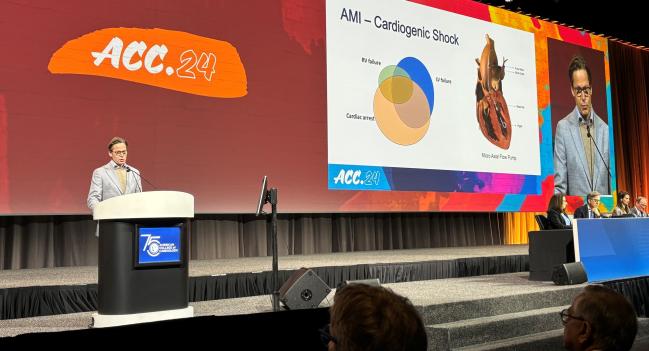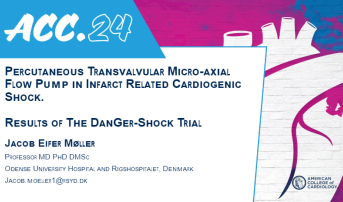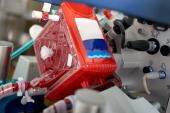Long-Awaited RCT Data Show Survival Benefit With Impella CP: DanGer Shock
The results, specific to STEMI patients with cardiogenic shock, are striking, experts say, but much work lies ahead.

ATLANTA, GA—For patients with acute MI complicated by cardiogenic shock (AMICS), the routine use of mechanical circulatory support (MCS) with the Impella CP (Abiomed) microaxial flow pump appears to achieve lower mortality at 180 days compared with standard care, according to long-awaited data from the randomized DanGer Shock trial.
Investigators also saw a higher rate of safety events with the Impella device, said Jacob Eifer Møller, MD, PhD, DMSc (Copenhagen University Hospital Rigshospitalet, Denmark), who presented the findings today at the American College of Cardiology (ACC) 2024 Scientific Session. And, because the trial solely enrolled STEMI patients, “I think we should be cautious not to extrapolate these results to other causes of cardiogenic shock,” such as out-of-hospital cardiac arrest (OHCA), non-STEMI, and nonischemic cardiogenic shock, he specified during his late-breaking presentation.
The DanGer Shock trial was published simultaneously online in the New England Journal of Medicine to coincide with the ACC meeting.
The Impella field has long had its share of champions and detractors: whether today’s data is enough to sway sceptics on the risk/benefit balance remains to be seen.
In an editorial accompanying the NEJM paper, Sunil V. Rao, MD (NYU Langone Health, New York, NY), says the findings represent a milestone for the field. “These striking results mark the first treatment strategy to show a benefit in patients with AMICS since the SHOCK trial, published in 1999, established percutaneous coronary intervention as the cornerstone of treatment,” he writes.
DanGer Shock—more than a decade in the making—kicked off enrollment in Denmark back in 2013 then expanded to Germany in 2019 and the United Kingdom in 2021. It emerged amid a contentious debate over what exactly observational data, some encouraging, some troubling, some muddied, provided in the absence of a large randomized controlled trial. All the while use of Impella has skyrocketed.
“This long period of enrollment reflects the patience and persistence of the investigators who continued the trial despite a substantial increase in the adoption of the microaxial flow pump into clinical practice without a solid evidence base to justify its use,” says Rao. “It also underscores the difficulty in performing randomized trials involving patients with AMICS because of issues related to informed consent, lack of equipoise, and appropriate patient selection, which can hinder trial progress.”
Notably, over the course of this decade, AMICS-related mortality in the wider world didn’t budge, he adds.
“It’s great for the field to finally have some positive randomized trial data to support [earlier] observations,” agreed Ajay Kirtane, MD (NewYork-Presbyterian/Columbia University Irving Medical Center, New York, NY), who commented on the new findings for TCTMD. He expects that outcomes with Impella will continue to improve, with fewer complications and adverse events as techniques, patient selection, and the device itself evolve.
Manesh Patel, MD (Duke University School of Medicine, Durham, NC), too, said DanGer Shock moves the field forward. It’s important to recognize, however, that the investigators “identified those patients who were high risk and had the opportunity to benefit [enough to] overcome some of the risks associated with any of these [MCS] devices,” particularly vascular complications, Patel noted.
Kirtane said that when physicians apply the finding to individual patients, they can be confident they have a treatment shown to be effective, but stressed the trial doesn’t mean Impella should be routinely used in all AMICS patients. “As great as it is to have this news, I do think a mistake would be to come out of it saying, ‘Everybody with shock needs hemodynamic support.’”
There is certainly a lot left to learn about Impella use, he added, but DanGer Shock “is a good lesson in how powerful it is to have randomized data.”
[It’s] a good lesson in how powerful it is to have randomized data. Ajay Kirtane
Nihar Desai, MD, MPH (Yale School of Medicine, New Haven, CT), senior author of a 2020 JAMA paper that used propensity matching in an attempt to overcome the downsides of observational data, an analysis that sparked controversy, also praised the DanGer Shock investigators for their persistence. But like Kirtane and Patel, he had caveats about generalizability. The trial was relatively small, said Desai, and enrolled selected STEMI patients—a subset of the overall cardiogenic shock population—in just a few countries at experienced centers. Additionally, it didn’t directly compare Impella against intra-aortic balloon pump.
“That being said, it’s awfully nice to have some data that suggest there’s a role for this device in these patients,” he commented.
Lower 180-Day Mortality
For DanGer Shock, investigators screened 1,211 potential participants, ultimately randomizing 360 patients with AMICS across 14 centers to receive standard care alone or with the addition of the Impella CP microaxial flow pump. All were in stage C, D, or E shock, as defined by the Society for Cardiovascular Angiography and Interventions–Cardiogenic Shock Working Group. Randomization occurred at the time of shock diagnosis, and the trial excluded patients with OHCA who remained comatose after arrival to the cath lab and those with overt RV failure.
Cardiogenic shock was established by three criteria: hypotension (systolic BP < 100 mm Hg or an ongoing need for vasopressor support), end-organ hypoperfusion with an arterial lactate level ≥ 2.5 mmol/L, and LVEF < 45%.
Subtracting five patients from the mix for whom informed consent could not be obtained, the final analysis included 355 patients. Mean age was 67 years, and 79% were male. Median levels for arterial lactate, systolic blood pressure, and LVEF were 4.5 mmol/L, 82 mm Hg, and 25%, respectively. Fully 84% of the patients were randomized in the cath lab, and overall the median time between onset of STEMI symptoms and randomization was 4 hours.
Nearly all (96.6%) underwent culprit-vessel PCI, while 1.4% underwent emergency CABG surgery.
Of the 179 patients in the Impella group, the device was successfully placed in 170 (95.0%). Three of the remaining patients (1.7%) crossed over to standard care and another six (3.3%) failed to have Impella successfully placed. For 28 patients (15.6%), treatment was escalated from Impella CP to another MCS type (ie, Impella 5.0, Impella RP, or extracorporeal life support).
Of the 176 patients in the standard-care group, three (1.7%) crossed over to a microaxial flow pump. For 37 patients (21.0%) treatment was escalated to another support system; extracorporeal life support was the recommended option, though Impella 5.0 was allowed.
By 180-day follow-up, 82 patients (45.8%) randomized to Impella CP had died from any cause, as compared with 103 patients (58.5%) assigned to standard care (HR 0.74; 95% CI 0.55-0.99; P = 0.04). The mean number of days alive and out of the hospital was 82 with Impella and 73 with standard care, a nonsignificant difference.
“One of the things that should be appreciated is that the survival curves seem to keep separating beyond day 30 and I think this is something we really have to understand and look further into,” said Møller.
This increase in survival, however, “did not come without a cost,” Møller noted. “We did see complications: there were clearly more adverse events in the [pump] group.”
The rate of complications is a true concern. Jacob Eifer Møller
The study’s composite safety endpoint—severe bleeding, limb ischemia, hemolysis, device failure, or worsening aortic regurgitation—was higher with Impella than with standard care alone (24% vs 6.2%; relative risk [RR] 4.74; 95% CI 2.36-9.55). Elevations also were seen in the individual endpoints of moderate/severe bleeding (RR 2.06; 95% CI 1.15-3.66), limb ischemia (RR 5.15; 95% CI 1.11-23.84), renal replacement (RR 1.98; 95% CI 1.27-3.09), and sepsis with a positive blood culture (RR 2.79; 95% CI 1.20-6.48).
The number needed to treat to avoid one death was eight, while the number needed to harm was six.
Subgroup analyses showed Impella was linked to significantly lower mortality in men but not in women. The survival benefit appeared greater in patients with mean arterial pressure ≤ 63 mm Hg (versus higher) and in patients with multivessel disease (versus single vessel).
Kirtane, the assigned discussant for DanGer Shock in the late-breaking session, got a round of applause in the Main Tent when he praised the investigators for “seeing it through to the finish.”
He pointed out that in the vast majority of the trial’s Impella-treated patients, the device was placed before reperfusion, whereas in clinical practice opening up the culprit artery is often the first step. “Should we really be changing our focus somewhat,” Kirtane asked, “away from the myopic fixation of artery opening and looking at the patient as a whole, particularly in these sick patients?”
“That’s obviously a very good question,” said Møller. “Many thought we were crazy 10 years ago when we came out with this study [design]. I think what kills the patient by the hour is the low cardiac output and what saves the patient in the long-term is the open artery, so we have to balance these two. If the patient [has] true depressed cardiac output, you have to get [them to] the possibility to open the artery. That’s our philosophy, and it seems to work.”
The ‘Safety Side’
A key thing to consider when digesting DanGer Shock, said Desai, is that while there was a reduction in mortality, “at the same time we did see pretty substantial increases in risk on the safety side.” Now, he continued, “the big question is: how would this device perform in unselected centers with unselected practitioners in a more diverse group of patients with cardiogenic shock? And that, I think, is still a major open question.”
Desai said US Food and Drug Administration’s recent Class I recall for the labeling of various Impella models—with 49 reported deaths—is a reminder that without careful use “these devices can have potentially catastrophic complications.”
There must be a balance between having a treatment available for these “very challenging, very sick patients who need it” and possessing the right expertise “such that that device can be deployed in a safe way where it can really be most effective,” he urged, noting that this applies not just to the cath lab but to what happens before and after. In the cardiovascular intensive care unit and elsewhere, “those teams have to be educated, and they have to be just as meticulous and just as diligent about device location, performance, and safety and monitoring for potential complications, because they can be quite serious,” said Desai.
Kirtane, in his comments during the session, asked Møller if he has any early insights into how to achieve even better results with Impella.
“The rate of complications is a true concern,” Møller acknowledged. “We’ve seen it in the registries, but here it’s in randomized data. That is something we have to take very, very seriously, especially when [treating] lower-risk populations.” In the sicker DanGer Shock population, “the benefit kind of overshadows the risk,” he added.
The big question is: how would this device perform in unselected centers with unselected practitioners in a more diverse group of patients with cardiogenic shock? Nihar Desai
According to the investigators, DanGer Shock “differs from other contemporary randomized trials of mechanical circulatory support in that it was conducted in a more homogenous patient population.” The requirement that participants have an elevated arterial lactate level in the absence of cardiac arrest meant that the population had “profound left ventricular failure and a high incidence of adverse events, as reflected by the substantial mortality that was observed beyond 30 days of follow-up,” they write, adding that this late mortality echoes earlier data from the National Cardiogenic Shock Initiative and other registries.
Rao points out, though, that the new results also are a departure from the negative findings for MCS in the previously released IABP-SHOCK II and ECLS-SHOCK trials. This could relate to the populations studied, the timing of the primary endpoint, the degree of hemodynamic support, or all of the above, he suggests.
For Rao, there are several unknowns that still have to be worked out in optimizing Impella use, including the timing of pump placement, the particulars of shock protocols, and clarity on how various types of MCS might best be combined. Some of these issues have already been queried in observational studies and now are being addressed in trials like RECOVER IV, he adds. “Until these data become available, the DanGer Shock trial is evidence of progress in the treatment of patients with AMICS whose peripheral vessels are able to accommodate the microaxial flow pump in the context of safe vascular access and closure and standardized weaning and removal protocols.”
When we identify that something works, how we actually implement it and get the results that are needed is the next big [step]. Manesh Patel
More-detailed analyses of DanGer Shock also will be fascinating to see, said Kirtane. A partial explanation for the difference in complications may be that the controls simply didn’t survive long enough for some of the events to occur, he suggested. “But we do know if you take a patient who is surviving and has a 14-Fr device put in through their small iliac, there’s a greater chance of having a problem than if you don’t put in that device, if everything else were the same.”
Kirtane said that things like prompt diagnosis and treatment of cardiogenic shock, as well as right-heart catheterization, can contribute to better outcomes.
Patel, for his part, emphasized training in best practices and a team-based approach to cardiogenic shock. “I do think these are achievable results,” he said. As to what should happen in DanGer Shock’s wake, Patel said, “When we identify that something works, how we actually implement it and get the results that are needed is the next big [step].”
To TCTMD, Møller said there are several ways to analyze the existing data as well as new information to gather going forward. The DanGer Shock investigators hope to continue with expanded follow-up to see whether the “signal we saw with separation of curves beyond day 30” is sustained, he said. “It will take some time,” since it requires new institutional review board approval in Germany.
Already the research team has details on how patients were managed in the ICU: what type of drugs were given and at what dose, as well as which ventilator settings were used. “These are technical things, but something that gives us insight into the effect and also how to avoid the adverse events,” Møller said, predicting the first such report will be coming out at TCT 2024.
Caitlin E. Cox is News Editor of TCTMD and Associate Director, Editorial Content at the Cardiovascular Research Foundation. She produces the…
Read Full BioSources
Møller JE, Engstrøm T, Jensen LO, et al. Microaxial flow pump or standard care in infarct-related cardiogenic shock. N Engl J Med. 2024;Epub ahead of print.
Rao SV. Mechanical circulatory support in cardiogenic shock — persistence and progress. N Engl J Med. 2024;Epub ahead of print.
Disclosures
- DanGer Shock was funded by the Danish Heart Foundation and Abiomed.
- Møller reports ongoing support to DanGer Shock, support to translational studies, and speakers fees from Abiomed; speakers/advisory board fees from Boehringer Ingelheim; grant/contract with Novo Nordisk Foundation; speakers fee from Orion; and support from Roche to analyze blood samples not related to DanGer Shock.
- Rao and Desai report no relevant conflicts of interest.
- Kirtane reports institutional funding to Columbia and/or Cardiovascular Research Foundation from Medtronic, Boston Scientific, Abbott Vascular, Amgen, CathWorks, CSI, Philips, Recor Medical, Neurotronic, Biotronik, Chiesi, Bolt Medical, Magenta Medical, Canon, SoniVie, and Shockwave Medical. He reports personal fees from Amgen, Medtronic, Biotronik, Boston Scientific, Abbott Vascular, CathWorks, Concept Medical, Edwards, CSI, Novartis, Philips, Abiomed, Recor Medical, Chiesi, Zoll, Shockwave, and Regeneron.







Comments